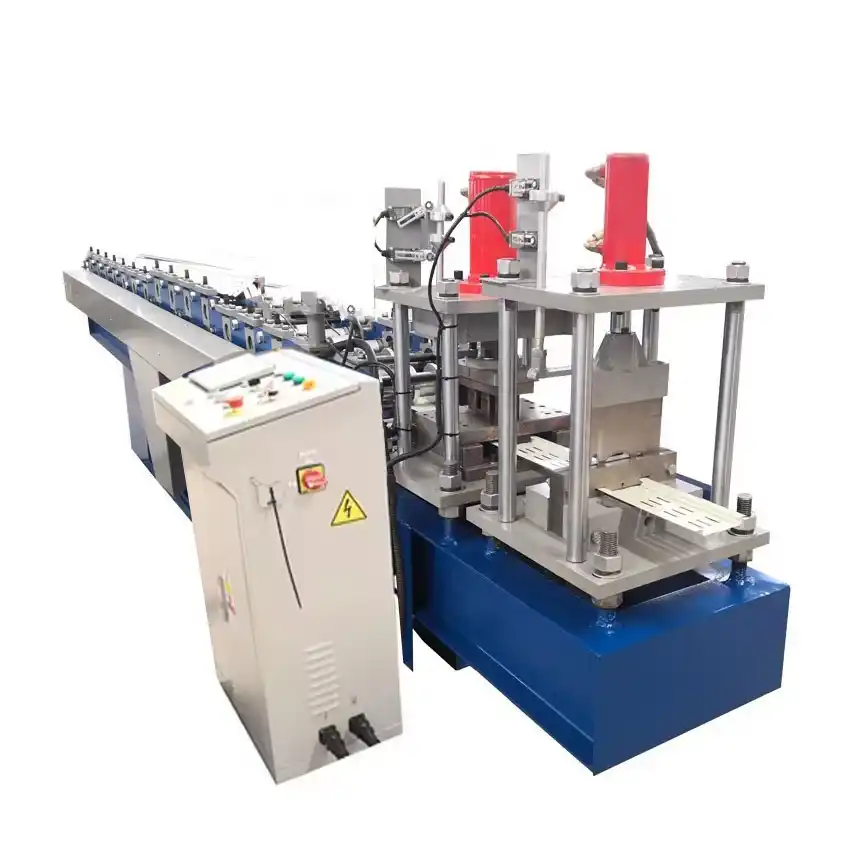Truss roll forming machine is a kind of equipment specially used for producing metal trusses, which are widely used in buildings, bridges, stadiums, industrial plants and other fields, especially in the construction of building structures such as walls, roofs, ceilings, etc.
The working principle of truss roll forming machine is usually to gradually press metal sheets (such as galvanized sheets, aluminum sheets, stainless steel sheets, etc.) into truss parts of preset shapes through a series of precision-designed rollers. These rollers are arranged at specific angles and sequences, and can form complex geometric shapes such as triangles, rectangles, trapezoids, etc. on metal sheets to meet the needs of different truss structures.
Feature of truss machine
- Truss roll forming machine is a popular truss machine used in sheet metal, construction, manufacturing industries to make galvanized steel roof truss.
- Their main advantages are beautifully customized designs, easy and stable operation with a strong body frame, with reasonable price.
- Roll forming roof C trusses and Batten roll forming machine are the perfect couple truss roll forming machine for a perfect luxury Villa roof.
There are many advantages to using truss roll forming machine to produce metal trusses:
- Efficient production: high degree of automation, can continuously and quickly produce a large number of truss parts, and improve production efficiency.
- High precision: roll forming technology can ensure the size and shape accuracy of truss parts to meet strict construction standards.
- High material utilization: by accurately controlling the rolling process, material waste can be reduced and material utilization can be improved.
- Low cost: compared with traditional manual or semi-automatic production methods, roll forming machine can significantly reduce production costs.
- Strong adaptability: The configuration and parameters of the rollers can be adjusted as needed to produce truss components of different shapes and specifications.
Profiles of truss machine

Application of truss machine
Metal keel ceiling roller pressing equipment is widely used in the construction field, especially in the production of ceiling systems. It can produce metal keels of various shapes and stable strength to meet the diverse needs of ceiling systems.
Other fields: In addition to ceiling systems, the equipment can also be used to produce other metal components, such as building frames, decorative lines, etc.
Component of stud and track machine
Machine Parts
1) Feeding

2) Rollers of Machine
Rollers are made of high-quality bearing steel GCr15, CNC lathed, heat-treated, and available with hard chrome coating.

3) Forming cutter

4)PLC Control system (2 type for choosing)
Easy to operate

Decoiler (2 type for choosing)
- Manual decoiler 2. Hydraulic decoiler


Our workshop


Truss roll forming machine production of metal trusses
1. Design layout
Calculate demand: Starting with the design criteria and building structure’s specifications, first ascertain the main factors including the form, size, and load-bearing capability of the necessary metal trusses.
Designs in drawings: To guarantee the accuracy and consistency of manufacturing, develop thorough truss design drawings according to the criteria, including the many components of the trusses, connecting techniques, dimensioning, etc., thus ensuring their uniformity.
2. Getting materials ready
Material choice: Choose appropriate metal sheets as raw materials, including galvanized sheets, aluminum sheets, stainless steel sheets, etc., per design drawing specifications. These components must to be machinable, have high strength and corrosion resistance.
To guarantee the cleanliness and adherence of the chosen metal sheets and get ready for further processing, pretreatment consists of cleaning, degreasing, and derust of them.
3. Roll shaping
Equipment debugging: Change the roller configuration and specifications of the truss roll forming machine to guarantee that the rollers may be pressed according to the preset shape and size based on the design drawings requirements.
The pre-treated metal sheet is fed into the truss roll forming machine, which deforms the sheet into a truss component of a specified form across a sequence of rollers. The operating state of the roll forming machine and the product quality have to be under constant observation throughout this procedure.
IV. later processing
Cut the truss components rolled as necessary to get the necessary length and form.
For later connection and installation, punch or punch holes in the truss components.
Welding creates a full truss framework for the truss components that must be joined.
V. Verification of quality
Examining the truss components’ surface quality—including fractures and uneven flaws—helps one understand them.
Measurement instruments help you to find if the truss component dimensions satisfy the design drawings’ specifications.
Load-bearing tests help to guarantee that the truss construction satisfies the usage criteria.
VI. storage and packing
Pack certified truss components to guard against damage during storage and transit.
Until later usage, keep the packed truss components dry, ventilated, non-corrosive atmosphere.

















